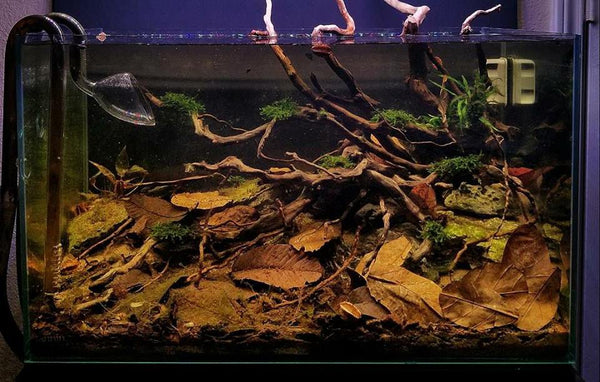- Continue Shopping
- Your Cart is Empty
Replicating Nature by Understanding Nature...
A simple thought for today...
When you really think about it, we as practitioners of the botanical-style blackwater aquarium are in a most unique position to learn first hand about how the fishes interact with- and benefit from- their physical environment.

We control many of the variables, such as the influx of new structural materials (ie; leaves and botanicals), the nutrient inputs and exports (ie, feeding and water exchanges), and the introduction and population density of fishes in the environment.

A blackwater, botanical-style system is quite analogous to the natural systems which depend on allochthonous inputs- food and nutrient sources from outside of the aquatic environment.

The allochthonous inputs in our instance are the addition and replacement of botanicals, such as seed pods, stems, leaves etc....in reality, "food" for multiple classifications of animals that reside in our systems.

The additions of these materials directly spur the growth of new and existing fungal and microorganism populations, supply supplemental food for some fishes (like detritivores and certain catfishes), and enhance the physical environment of the aquarium by providing additional hiding space and territories.

Part of the game, as we've discussed ad naseum here, is to understand, appreciate, and ultimately embrace the way the aquatic environment is influenced by the fungal growths, biofilms, and decomposition which occurs when botanicals are added into our aquariums.
And, as we often say, that means making a mental shift to accept the unique aesthetics of a botanical-style aquarium: Brown water, stringy biofilms, and decomposing leaves and botanicals. All have their place in our world. The most challenging part of starting and managing one of these "functionally aesthetic" systems is to appreciate not only how they function, but to understand why the way they look the way they do.

To those of you just jumping into this world, I assure you it's like no other aquarium you've ever maintained. Botanical-style aquariums embody the art of observation and study. Much like managing any type of aquarium, the successful botanical-style aquarium is about understanding a balance.

You'll get it- after than initial, "What have I done? What's all of this biofilm stuff..." freakout...
Something clicks. And you'll understand.
I think we're starting to see a new emergence of a more "holistic" approach to aquarium keeping...a realization that we've done amazing things so far, keeping fishes and plants in a glass or acrylic box with applied technique and superior husbandry...but that there is room to experiment and push the boundaries even further, by understanding and applying our knowledge of what happens in the real natural environment.
You're making mental shifts...replicating Nature in our aquariums by achieving a greater understanding of Nature...
You're laying down the groundwork for the next great phase of aquatic husbandry innovation and breakthrough.
Here's to a happy Holiday Season and many exciting innovations in 2019!
Stay healthy. Stay happy. Stay excited. Stay curious. Stay festive...
And Stay Wet!
Scott Fellman
Tannin Aquatics







Scott Fellman
Author